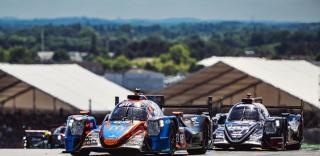
Limited to “Le Mans Prototype” and “Le Mans Grand Tourer” type cars, the European Le Mans Series features three categories: LMP2, LMP3 and LMGTE. Each year, titles are awarded to the drivers and teams topping the standings in each of the three classes. The winners of each category also obtain an invitation to participate in the next year 24h of Le Mans. Since 2021, LMP2 Pro/Am standings have been added, both for drivers and teams, wherever there is at least one Bronze driver in the crew.
LMP2
Feeder category to the top-tier FIA World Endurance Championship (WEC) Hypercar class, LMP2 is the highest category in the ELMS and is very popular with independent teams. This is due to both its high-level performances (carbon-fibre monocoque chassis supplied by Dallara, Ligier Automotive, Oreca or Riley Tech/Multimatic and Gibson 4.2-litre, 536hp, normally-aspirated V8 engine) and its controlled costs. Goodyear is the category’s sole tyre manufacturer. Lastly, each crew must include at least one “Silver” or “Bronze” driver.
LMP3
Seen as a way for drivers to cut their teeth in Endurance racing, the LMP3 class is the first step for those looking to learn about driving a prototype. The cars are provided by four different manufacturers – Ligier, Duqueine Engineering, Ginetta and Adess – whilst the powertrain (engine, gearbox and electronics) is exclusively supplied by Oreca, delivering some 455 horsepower. Michelin is the designated tyre supplier.
LMGTE
The GT cars are part of the tradition of Endurance racing, providing joy to amateurs and licensed drivers alike. To be homologated, a GTE (E for Endurance) must be derived from a road car of which at least 100 have been built (25 for a “small manufacturer”, 300 for a carbon-fibre chassis). The “racing” version must retain the shape of the road model from which it is derived and the performances of the various brands are adjusted through a Balance of Performance mechanism.







